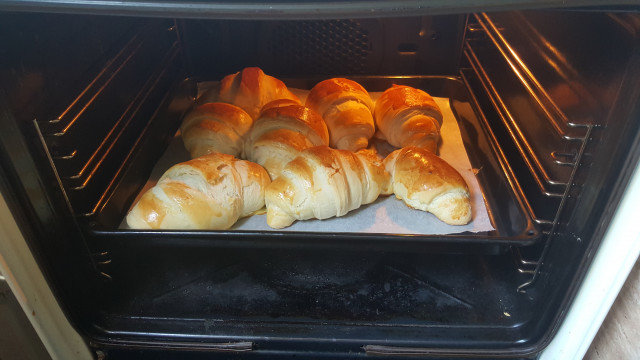How to make
Cut the butter into long pieces, put them in the middle of a large sheet of baking paper, fold the ends inward to make it like a packet. Mash with a rolling pin, then roll it out to a 6 1/2″ (16 cm) square through the paper itself. Leave in the fridge to harden.
Dissolve the dry yeast in a little milk with 1/2 tsp sugar to make it effervescent.
Prepare your mixer. Sift the flour into the mixer's bowl, add the salt, sugar and then the milk in a thin trickle. Beat with the mixer on medium. Form a nice ball of dough, transfer it to a lightly floured counter and finish kneading by hand another 1-2 min. max, until it becomes soft and stretchy.
Transfer it to a buttered bowl, wrap with foil and leave to rise until doubled in volume. Once doubled, knead again briefly, wrap with foil and leave in the fridge for at least 1 hour. For the next step, it's important that the dough and butter are the same temperature when you start working with them.
Put the cooled dough on a lightly floured counter and roll out the 4 ends with rolling pin into a cross-like shape. Put the square of cold butter in the middle. Subsequently, fold the ends of the dough inward, on top of one another, to form a packet. Clean off the excess flour with a brush.
Roll out the packet into a rectangle, carefully and without applying too much pressure, its length needs to be 3 times greater than its width. Be sure to roll out in a back and forth motion only, as this is one of the requirements for superb croissants. Fold the long rectangle in 3, like a letter or book, leaving a little space in the middle in order to be able to fold the dough there. This is the 1st roll out of the dough for the croissants. Wrap with foil and leave in the fridge about 30-40 min., so that it can cool for the 2nd roll out.
2nd roll out: remove from the foil and place the dough onto a floured counter in such a way that the folded ends are facing you. Start rolling out in a back and forth motion only, and again roll it out to about 3 times longer than its width. Transfer to a plate, cover with foil and leave in the fridge about 30-40 min. again. Repeat this process another 4 times, for a total of 6 times total.
Important! If at any point while rolling out the dough it starts to tear or sticks to the counter or rolling pin, it means you have to return it to the fridge immediately and wait for it to harden again and begin anew. After you roll it out the final 6th time, shape it into a packet again and put in the fridge for another 30-40 min.
To shape the croissants, place them again on a floured counter and, facing you, roll them out to 1/4 thick, again with a back and forth motion only. The sheet can reach up to 3.5 ft (1 m) in length. Cut out triangles with a base of about 4″ (10 cm), sides of about 6″ (15 cm). Stretch out each triangle with your hands, make cuts every 3/4″ (2 cm) along the length of the base, to make it easier to roll up each croissant, plus it helps for better baking. Roll them up.
Arrange them onto baking paper with some space in between them and leave to rise 40-50 min. Smear with the egg and milk. Bake at 390°F (200 °C) about 20-25 min.
Notes: The butter packet needs to be a 6 1/4″ (16 cm) or 7″ (18 cm) per side square. When you roll it out the 1st time it'll be about 25 1/2″ (65 cm) in length and 17 1/2″ (44 cm) in width, while reaching up to 44″ (112 cm) in length after rolling out subsequently.
Put in preheated 430°F (220 °C) oven initially, then lower and bake at 370°F (190 °C). Use a pizza knife to cut out triangles from the dough. Make sure you write down which roll out you're on, so there's no confusion. The most important thing is to have the dough cold enough when working with it.















